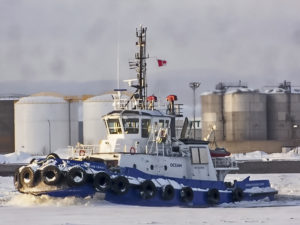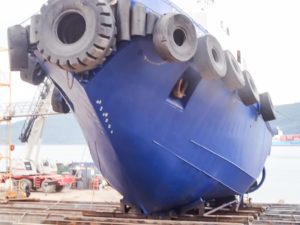More news
- PPG recognised for sustainability progress by FTSE4Good for sixth consecutive year
- Focus on industrial: Powering the energy industry during extreme heat
- Focus on powder coatings: The coatings industry’s transition to PFAS/PTFE-free solut...
- Birla Carbon Plants in USA, Canada, and Spain secure ISCC PLUS Certification
- Songwon awarded platinum level by EcoVadis for its sustainability achievements

Group Ocean has been applying Ecospeed Ice on all their ice going tugs since January 2012. “What we were looking for was a 25-year corrosion protection system for our ice-going tugs,” says Patrick Chabot, Director of Fleet Planning and Renewal at Group Ocean in Québec, Canada. “We do not want to do any corrosion/erosion steel work,” he adds. “I believe we have now found that 25-year solution.”
Gordon Bain, Founder and Chairman of Group Ocean’s Board of Directors recalls, “When I founded Aqua-Marine in 1972, I had a dream: to provide integrated marine services. The commitment, ingenuity and trust of the teams that supported me in this journey, along with our clients’ trust, have allowed us to become a leader in the maritime industry.”
The company originally specialised in underwater work. In 1987 it evolved into Ocean Construction Inc. and acquired Québec Tugs, Ltd. Through a series of subsequent acquisitions and expansion moves, including the outright purchase of the Isle-aux-Coudres shipyard in 1997 which was then renamed Ocean Industries Inc., Ocean has become one of the main suppliers of integrated marine services in Canada and a leader in the Canadian marine industry.
Since then the expansion and acquisitions have continued. In 2017, Ocean acquired three tugs from Svitzer in Canada. In 2018, the company expanded into Western Canada and the Caribbean. In 2019, Ocean was awarded its largest shipbuilding contract to date: four large tugs for Canadian National Defense. In 2021, Ocean Group acquired Samson Tugboats in Vancouver.
In 2022, Ocean Group acquired Shipyard Verreault in Quebec. Founded in 1956 by Captain Borromée Verreault, this shipyard specialises in ship repair and transformation, and plays a leading role in the Quebec and Canadian maritime industry. With this acquisition, Ocean Group increased its capacity and expertise to meet the needs of its customers. The acquisition brought with it two Verreault shipyard tugs that currently provide services at the Les Méchins and Matane docks.
Tugboats and ice
Over the years, Ocean has built up a fleet of tugboats, many of which are ice-strengthened and equipped to operate in the severest winter conditions. In 2005 a fleet renewal programme began with the christening of the Ocean K. Rusby, a new state-of-the-art tug powered by Z-drive propellers. This was the first of eight new tugs.
Ocean has built the most powerful tugs in Canada, designed by Robert Allan Ltd., naval architects and marine engineers. Canada has a vast Arctic frontier, an east coast subject to extreme winter conditions, and the Great Lakes which experience severe ice conditions every winter. For decades, Robert Allan Ltd. has worked with clients operating in these cold weather regions and has learned many of the secrets of designing ice-capable tugs. These not only meet the class rules for hull strength, but incorporate many of the critical lessons learned to make these boats safe and practical to operate in this extreme climate. Every one of these vessels is uniquely designed for a specific set of operating conditions. The Ocean ice-going tugs are all ice-class 1 AS FS.

Caption: The Ocean Raymond Lemay in action in Quebec. Ecospeed Ice protects the hull for the life of the tug.
Hull coating
The Ocean tugboats are generally built for service in harsh, icy conditions. The coating used on the hull is very important for a number of reasons and Group Ocean experimented with several options before finding the right one.
“Before we found Ecospeed Ice in 2011, we had been using an epoxy paint from one of the major paint manufacturers,” says Patrick Chabot. “It doesn’t work. The ice is very damaging to the paint, even an epoxy paint. Before that we had some vessels with one of the more generally used ice-abrasion resistant hull coatings,” Patrick continues. “The application of that coating is so expensive, and you need a special pump with twin hot feeds, and summer conditions. Most of our docking happens at the end of summer or in the winter and it is very hard to achieve the needed temperature control. That’s one of the reasons we moved away from that coating to Ecospeed Ice. We are very satisfied with the application of Ecospeed, which can be accomplished with normal spray equipment and is much more tolerant of the conditions in which we have to operate.”
Ecospeed Ice is a glass platelet reinforced coating which has been granted ice-class classification PC 6 to PC 7 by Lloyds Register. The use of the coating permits the reduction in thickness of the steel plates of an icebreaker or ice going ship by 0.5-2mm, according to the relevant Rules.
In 2011, the subject of coatings came up at the Ocean yard. “We did not want to go with normal epoxies because they just don’t stay on,” recalls Patrick. “We decided to look for a new paint programme. Everyone was OK with the specialised ice coating we had tried but the application was too difficult. We decided to look for something else. That was when we got in touch with Subsea Industries. We tested two different coatings. One was Ecospeed Ice. The other was an ultra-high build, high volume solids, two component catalysed epoxy recommended by the same paint manufacturer as had supplied our earlier coatings. They did not want to give up without a fight! After a year we were more impressed with Ecospeed Ice. The two boats work in the same area, so we had a very good comparison. After one year in the ice, the epoxy paint did not stay on at all. Most of the forward section and forward bottom section had no paint left on at all. All the paint was removed by the ice. With Ecospeed, the forward plates were all fine and we had no problems, except with some of the weld seams which started to show some signs of wear after some time. We are now addressing this with stripe coating on application.”
The Ecospeed Ice applied in 2012 is still in excellent condition. Olivier Garon, Director of Fleet Maintenance sees each tug when it comes into drydock. “I am very impressed with the hull condition,” he notes. “When they’re in drydock, I can see right away which vessels were painted with Ecospeed and which were not. The difference is very noticeable. There are maybe just a few little touch-ups to do, probably resulting from mechanical damage rather than from the ice, most likely anchor chain or something like that. The application has been done per instructions, so it lasts. I’m really impressed.”

Caption: The Ocean Sept-Isles in drydock three years after Ecospeed Ice was applied.
Bruno Beaulieu, Ocean’s Technical Director also notes, “We have the natural antifouling system which is called winter conditions in ice, which cleans the hull very thoroughly during the winter. But with Ecospeed we do not see very much fouling, even in summer.” Ecospeed Ice is a totally inert, hard coating which does not contain biocides of any kind or leach any toxic substances. The fouling resistant properties stem entirely from the smoothness, impermeability and impenetrability of the coating. If fouling does accumulate, it is very easy to clean off without any harm to the coating or the environment.
Since the first tug, the Ocean Raymond Lemay was coated with Ecospeed Ice in January 2012, Ocean has gone on to apply the same coating to an additional 11 tugs and the passenger ferry Lomer-Gouin, the most recent being in 2018. Not only has the underwater hull been coated but, because the results looked so good, the boot-top and topsides have also been coated with Ecospeed Ice with excellent results.
Benefits
When asked to describe the main advantages of Ecospeed Ice for Ocean, Patrick Chabot said, “For our conditions, the ease of application is one of the key points. We do not have a closed facility for painting so it’s hard to achieve the special conditions required for some coatings. For us, that’s a big winner. Wear resistance is a very good gain because this is what we were looking for. I like the fact that the equipment for painting is really simple – just a good pump. Costs are minimal. And we can choose the colour we want! We can do Ocean blue. We are a very satisfied customer because we achieved all our goals. The only remaining issue is a small adjustment to handle the seams, the Z-drive and Kort nozzles and we are going to use Ecoshield for them.” They are looking into the very real possibility of the manufacturer of the Z-drives used on the tugs supplying them ready-coated with Ecoshield, which would be a great improvement over regular epoxy.
Bruno Beaulieu adds, “You don’t need heated shelters because you have a bigger window for application.” Ecospeed Ice can be applied in temperatures ranging from 0°C (32°F) to 60°C (140°F), which is quite a wide tolerance.
Reduced costs
Patrick also notes the reduced lifecycle costs. “The initial application is quite expensive [Ecospeed Ice is applied to a thickness of 1000µm or 40mil, which is thicker than many epoxy coatings which are not designed to last very long in the ice] but the gain in longevity and the steel you don’t have to replace compensates for that completely.” The use of Ecospeed Ice greatly reduces time in drydock since repainting is not required, and then of course there is the cost of the replacement paint itself and its application which is not required in the case of Ecospeed Ice.
“What we were looking at was to get a 25-year corrosion protection system. I believe we now will achieve that thanks to Ecospeed Ice.”
This is a case study from www.subind.net
For more information, contact:
READ MORE:
Focus on marine: Australia leads the way in marine coatings inspired by nature
Focus on marine: Hempel dives into sustainability collaboration
Asia regulatory update: March 2023



